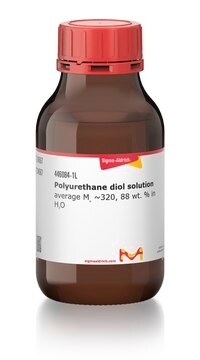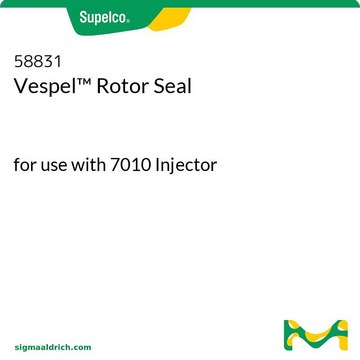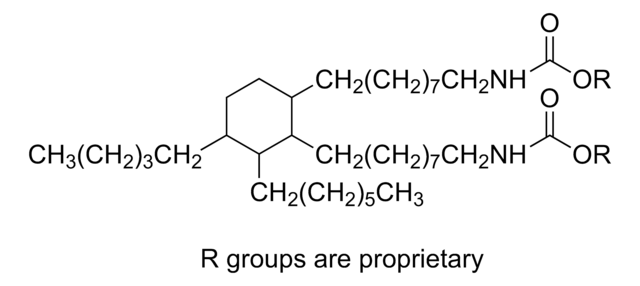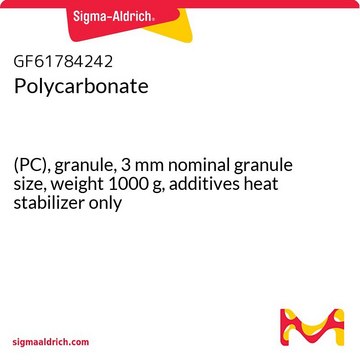About This Item
Polecane produkty
klasa czystości
for ion-selective electrodes
Poziom jakości
linia produktu
Selectophore™
Formularz
beads
Opis ogólny
Polyurethanes are a broad class of polymers which have urethane group (-NHCO-O-). Urethane group is formed by isocyanate reacting with hydroxyl groups.
Visit our Sensor Applications portal to learn more.
Zastosowanie
Polymeric membrane material for chemosensors and biosensors
Polyurethane was used as an outer coating membrane to increase stability and the linear range of the sensor during development of glutamate microbiosensor. It may also be suitable in investigating the thermal degradation of α,γ-diphenyl alkyl allophanates and carbanilates for crosslinking sites using pyrolysis-high-resolution gas chromatography/FT-IR (Py-HRGC/FT-IR).
Inne uwagi
Membrane material with favourable properties for sensors, e.g. long-term electrochemical stability, improved biocompatibility, etc.
Informacje prawne
Selectophore is a trademark of Merck KGaA, Darmstadt, Germany
Ta strona może zawierać tekst przetłumaczony maszynowo.
Kod klasy składowania
11 - Combustible Solids
Klasa zagrożenia wodnego (WGK)
WGK 3
Temperatura zapłonu (°F)
Not applicable
Temperatura zapłonu (°C)
Not applicable
Środki ochrony indywidualnej
Eyeshields, Gloves, type N95 (US)
Wybierz jedną z najnowszych wersji:
Certyfikaty analizy (CoA)
Lot/Batch Number
Nie widzisz odpowiedniej wersji?
Jeśli potrzebujesz konkretnej wersji, możesz wyszukać konkretny certyfikat według numeru partii lub serii.
Masz już ten produkt?
Dokumenty związane z niedawno zakupionymi produktami zostały zamieszczone w Bibliotece dokumentów.
Klienci oglądali również te produkty
Thermal degradation mechanism of a, ?-diphenyl alkyl allophanate as a model polyurethane by pyrolysis-high-resolution gas chromatography/FT-IR.
Yoshitake, Norimichi, and Mutsuhisa Furukawa.
Journal of Analytical and Applied Pyrolysis, 33, 269-281 (1995)
Polyurethane elastomers.
Petrovic, Zoran S., and James Ferguson.
Progress in Polymer Science, 16, 695-836 (1991)
M.E. Meyerhoff et al.
Polym. Mater. Sci. Eng., 64, 293-293 (1991)
S Y Yun et al.
Analytical chemistry, 69(5), 868-873 (1997-03-01)
Potentiometric responses of polyurethane (PU)-based membranes containing valinomycin and varying amounts of plasticizer (DOA) and/or lipophilic additive (KTpClPB) were examined as a function of soft segment [poly(tetramethylene ether glycol)] contents in aromatic diisocyanate-based PU matrices. Upon increasing the weight percentages
E. Lindner et al.
Electroanalysis, 7, 864-864 (1995)
Nasz zespół naukowców ma doświadczenie we wszystkich obszarach badań, w tym w naukach przyrodniczych, materiałoznawstwie, syntezie chemicznej, chromatografii, analityce i wielu innych dziedzinach.
Skontaktuj się z zespołem ds. pomocy technicznej



![Poly[4,4′-methylenebis(phenyl isocyanate)-alt-1,4-butanediol/di(propylene glycol)/polycaprolactone] pellets, MDI-polyester/polyether polyurethane.](/deepweb/assets/sigmaaldrich/product/structures/661/697/b23c24ce-15fb-4eae-a30f-786921d4c91e/640/b23c24ce-15fb-4eae-a30f-786921d4c91e.png)






